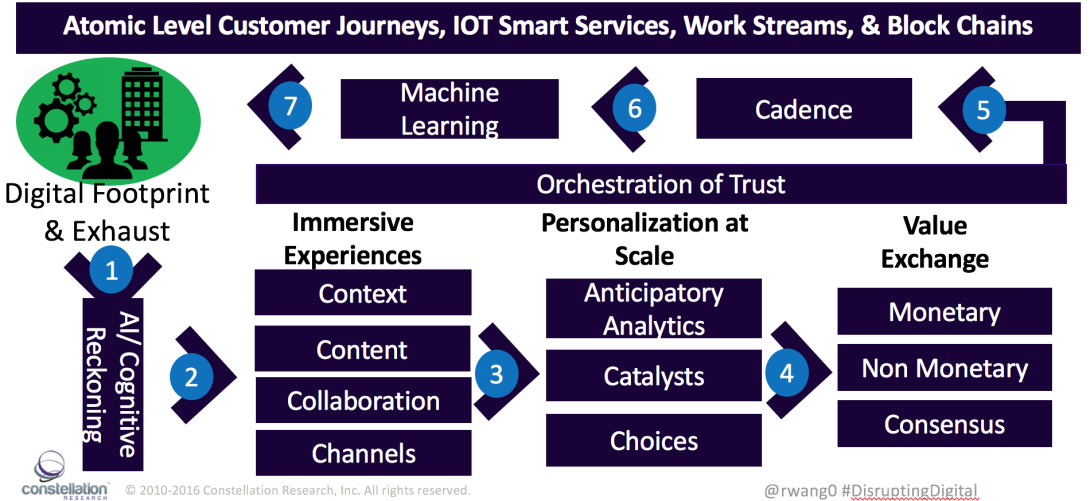
Monday's Musings: Secrets Behind Building Any AI Driven Smart Service

AI Driven Smart Services Power The Future of IOT, CX, Future of Work, and Block Chains
The combination of machine learning, deep learning, natural language processing, and cognitive computing will change the ways that humans and machines interact with our environments. AI-driven smart services will sense one's surroundings, know one's preferences are from past behavior, and subtly guide people and machines through their daily lives in ways that will truly feel seamless. This quest to deliver AI driven smart services across all industries and business processes will usher the most significant shift in computing and business this decade and beyond.
Organizations can expect AI driven smart services to impact future of work flows, IOT services, customer experience journeys, and block chain distributed ledgers. Success requires the establishment of AI outcomes (see Figure 1). Once the outcomes are established, organizations can craft AI driven smart services that orchestrate, automate, and deliver mass personalization at scale.
Figure 1. Seven Spectrum of AI Outcomes

Secrets To Designing AI Driven Smart Services Start With The Orchestration Of Trust
Crafting AI-driven smart services requires a shift in thinking to atomic driven smart services. In fact, these new AI driven smart services rely on five key components:
- Applying digital footprints and data exhaust use AI to build anonymous and explicit profiles.
Every individual, device, or network provides some information. That digital footprint or exhaust could come from facial analysis, a network IP address, or even one’s walking gait. Using AI and cognitive reckoning, systems can start to analyze patterns and correlate identity. That means that AI services will recognize and know individuals across difference contexts. - Immersive experiences enable a natural interaction.
Context, content, collaboration, and channels come together to all AI-driven services to deliver immersive and unique experiences to each individual. The services will use context attributes such as geospatial location, time of day, weather, heart rate, and even sentiment – combined with what the service knows of our identity and preferences - to improve relevancy and deliver the appropriate content. Sense-and-respond mechanisms will enable collaboration among participants and machines through conversations and text dialogs. Channels include all interaction points such as mobile, social, kiosks, and in-person. The goal is natural user experiences based on identity. - Mass personalization at scale delivers digital services.
Anticipatory analytics, catalysts, and choices interact to power mass personalization at scale. Anticipatory analytics allow customers to “skate where the puck will be”. Catalysts provide offers or triggers for response. Choices allow customers to make their own decisions. Each individual or machine will have their own experience in contexts depending on identity, historical preferences, and needs at the time. From choose-your-own-adventure journeys, context-driven offers, and multi-variable testing on available choices, the AI systems offer statistically driven choices to incite action. - Value exchange completes the orchestration of trust.
Once an action is taken, value exchange cements the transaction. Monetary, non-monetary, and consensus are three common forms of value exchange. While monetary value exchange might be the most obvious, non-monetary value exchange (including recognition, access, and influence) often provide a compelling form of value. Meanwhile, a simple consensus or agreement can also deliver value exchange on the veracity of a land title or agreement on a patient treatment protocol. - Cadence and feedback continues and AI powered learning cycle.
Powered by machine learning and other AI tools, smart services consider the cadence of delivery: one time, ad-hoc, repetitive, subscription based, and threshold driven. Using machine learning techniques, the system studies how the smart services are delivered and applies this to future interactions.
Figure 2. The Secret To Designing Atomic AI Driven Services

The Bottom Line: Artificial Intelligence Augments Humanity
Fears of robots taking over the world have been overblown. Successful AI driven smart services will augment human intelligence just as machines augmented physical capabilities. By enabling reduction of errors, improving speed of decisions, identifying demand signals, predicting outcomes, and preventing disasters, AI driven smart services play a key role in defining business models for block chain technologies, IOT, customer experience, and future of work.
Take a look at an example applied to an AI Driven Hospital in Harvard Business Review
Your POV.
Are you ready to unlock the powers of Artificial Intelligence? What’s your entry point? Machine learning, natural language processing, topological data analyses? Would you like to hear what other organizations have embarked on? Would you like us to present to your boardroom? Learn how non-digital organizations can apply an AI road map to disrupt digital businesses in the best-selling Harvard Business Review Press book Disrupting Digital.
Add your comments to the blog or reach me via email: R (at) ConstellationR (dot) com or R (at) SoftwareInsider (dot) org.
- Developing your digital business strategy
- Connecting with other pioneers
- Sharing best practices
- Vendor selection
- Implementation partner selection
- Providing contract negotiations and software licensing support
- Demystifying software licensing
Resources
- Monday’s Musings: Understand The Spectrum Of Seven Artificial Intelligence Outcomes
- Tuesday’s Tip: Seven Factors For Precision Decisions In Artificial Intelligence
- Monday’s Musings: Data – The Foundation Of Real-Time Digital Business
- ‘Monday’s Musings: Who Gets To Be A Chief Digital Officer?
- Monday’s Musings: The Seven Rules For Digital Business And Digital Transformation
- Tuesday’s Tip: Five Steps To Starting Your Digital Transformation Initiative
- Monday’s Musings: What Organizations Want From Mobile
- Research Summary: Economic Trends Exacerbate Digital Business Disruption And Digital Transformation (The Futurist Framework Part 3)
- Research Summary: Five Societal Shifts Showcase The Digital Divide Ahead (The Futurist Framework Part 2)
- Research Summary: Sneak Peaks From Constellation’s Futurist Framework And 2014 Outlook On Digital Disruption
- Research Report: Digital ARTISANs – The Seven Building Blocks Behind Building A Digital Business DNA
- Research Summary: Five Societal Shifts Showcase The Digital Divide Ahead (The Futurist Framework Part 2)
- Research Summary: Next Generation CIOs Aspire To Focus More On Innovation And The Chief Digital Officer Role
- Trends: [VIDEO] The Digital Business Disruption Ahead Preview – NASSCOM India Leadership Forum (#NASSCOM_ILF)
- News Analysis: New #IBMWatson Business Group Heralds The Commercialization Of Cognitive Computing. Ready For Augmented Humanity?
- Harvard Business Review: What a Big Data Business Model Looks Like
- Monday’s Musings: How The Five Consumer Tech Macro Pillars Influence Enterprise Software Innovation
- Tuesday’s Tip: Understand The Five Generation Of Digital Workers And Customers
- Monday’s Musings: The Chief Digital Officer In The Age Of Digital Business
- Slide Share: The CMO vs CIO – Pathways To Collaboration
- Event Report: CRM Evolution 2013 – Seven Trends In The Return To Digital Business And Customer Centricity
- News Analysis: Sitecore Acquires Commerce Server In Quest Towards Customer Experience Management
- News Analysis: Salesforce 1 Signals Support For Digital Business at #DF13
- Research Summary And Speaker Notes: The Identity Manifesto – Why Identity Is At The Heart of Digital Business
 R "Ray" Wang
R "Ray" Wang R "Ray" Wang
R "Ray" Wang